Memories of Dermot aka Barney, and Michael Perry

The Perry house at Glenside in 1948. From left: Josephine Perry; her mother Millicent holding baby Michael; Theresa (Millicent's sister); Dermot holding Michael's teddy bear. Image is a scan of a photocopy of the original. Photo courtesy Barney Perry.
Background - The hard working Perry family
These are the reminisces of Barney Perry, also known as Dermot, and Michael Perry. The Perry boys grew up on the historic Braid farm in Glenside from 1937 to 1958. Their parents were James Joseph Perry (d1976) of Country Meath, Ireland and Millicent Alethea Perry nee Smith (1911-1997) of Makikihi, Waimate. They were married in 1926. The Perry children are:
Josephine Millicent Perry (1926 - 2013)
Edward Graham Perry (1930 - 2019). Known by the name Graham.
James Dermot Patrick Perry (1936 - 2013). Known by the name Dermot until he joined the Merchant Navy, then became known as Barney.
Michael Dennis Perry (b1947).
In 2001 Barney and his wife Virginia came to visit the farm. It was the first time Barney had returned since the family moved away in 1958. In 2019 Mike and his wife Sue came to visit and this was Mike's first visit since the Perry’s moved away when he was a nine-year-old boy. Their reminices were written down by Claire Bibby, the owner of the historic cottage.
The early days, before Glenside
Mike Perry
"Dad was born in County Meath, Ireland in the 1890's. The family never knew his true age as he wanted to get out of Ireland at a young age. The only way out was to join the British Army and he had to lie about his age to get into the Army. As a young man he served in World War One as a medic on the front line. After he was shot and injured, he continued his War service in Scotland as a hospital orderly, caring for service personnel recovering from their injuries. When the War ended, he worked on farms in Scotland."
"He could never go back to Ireland. There were reprisals and the family house was attacked and his brother, our Uncle Jack, had his leg blown off. Dad was always suspicious of any Irish person he met, even here in New Zealand. This included the Irish priests."
"He had a talent caring for farm animals and in time obtained a job caring for stock on a ship to New Zealand. He jumped ship in New Plymouth and eventually found his way to the South Island working on farms. He met our Mum, Milly, at a dance in Timaru. She came from Makikihi, Waimate."
The Perry's ended up in in the North Island and by 1937 Joseph, who was good at handling horses, was working as a milkman for Wellington City Council. The couple lived in Majoriebanks Street in the city. There was an epedemic sweeping the city and fearing for the health of their daughter Josie, they moved out into the country, buying a small farm of 21 acres at Glenside.
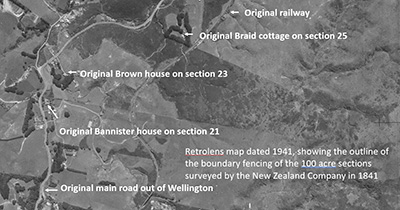
Above: Aerial map overlay dated 1941 showing the location of the original Braid Farm cottage. The cottage on 21 acres was purchased by the Perry family in 1937. The old route of the 1885 railway can be seen cutting through the farm. The motorway, which opened on 23 December 1950, generally follows the course of the former railway. Source: Retrolens online.
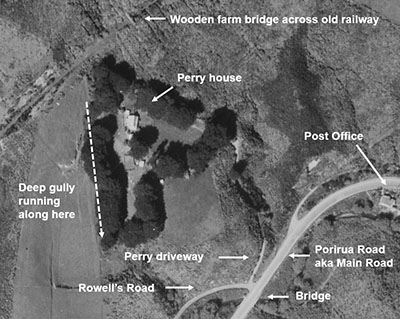
1945 Aviation photograph sourced from Retrolens online.
The Perry farm included a cottage, stables, cow bails and a pig pen. Water was supplied from a freshwater spring to the north west of the cottage. Behind the cottage was a deep gully and creek.
In those days the farm cottage was accessed from a steep driveway at the corner of Rowell’s Road and the old main road - the latter was later renamed Middleton Road.
Many changes have taken place during and since the Perry era. The house spring dried up when the railway tunnel was constructed in the 1930’s. In the big storm of 1947 most of the farm buildings were crushed by falling trees. In 1996 the steep driveway was closed off when the farm was subdivided for the construction of the Glenside interchange and Westchester Drive. The big deep gully and stream behind the house was filled in to develop a motorway off-ramp.
Despite all these changes, the historic cottage and gardens remain in a semi-rural bush setting adjacent to the large Glenside Reserve.
Arriving in Glenside
Barney Perry
"Dad bought the place for $450- 495 pounds in 1937. The lawyers were Finlay and Foote of Wellington. I believe his mortgage was $1 pound a month. Dad (Joseph) was Irish and Mum (Millicent) was part Irish with an English born Australian father. She was a Smith, and her mother was a McGirr, one of the "mad" McGirrs. The McGirrs had a reputation for their wild Irish behaviour."
"With the house there was 21 acres of land. After the railway deviation went through it was reduced to 17 acres. There were cow bails, a pig pen, stables. The house was surrounded by huge macrocarpa trees."
Dad’s world in Glenside
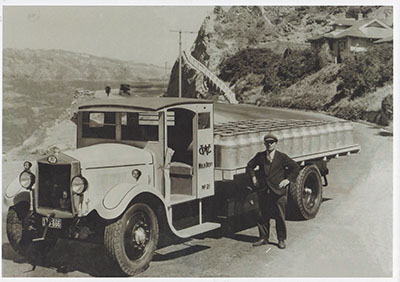
c1933. Joseph Perry and milk truck in a Wellington City Council promotion photo. Photo courtesy Michael Perry.
Barney Perry
"Dad worked for the Wellington City Council and he bought his job. It was the height of the depression, and he went to see the foreman, who said that he had no jobs. However, the foreman also said he was getting married and was short of cash so Dad gave him a loan and in return the foreman gave him a job, which was to last 28 years."
"Dad worked at night, driving a milk cart and a milk tanker, delivering milk. Dad used to set off for work at one o'clock in the morning. He worked shift work and there were a lot of call backs. He worked from Tory Street. He used to go as far north as Otaki collecting milk. There was a receiving vat at Otaki where the milk was collected from the surrounding farms and poured into this ice cold vat. Dad used to collect it from there where it was taken back to Tory Street by horse and cart to be pasteurised. One of his jobs was to deliver crates to a base at Karori where the horses and carts delivering milk would collect them.
Mike Perry
"Dad held a few jobs but his main job was the milk truck driver for the City Council. When they put the motorway through in the fifties, he would do the early run up to Otaki to get the milk then on the way home he would park up on the side of the motorway outside the house and hop over the paddocks to come home for breakfast!"
"He drove a meat truck at one time and he also worked at Porirua hospital as an orderly. He had been a medic in a Military hospital in Scotland during World War One and was experienced in working with patients, including those who were disturbed."
"Dad had a very good reputation as a milk truck driver for the Council and that is why he was used in the promotion photo, which was taken in about 1933."
"In the 1950’s in Glenside, there was a guy who used to drive around in a car converted into a truck and he used to come around and fill your milk from a can. If we were short of milk, we would put our can out down the bottom of the road with some coins and he would fill it. Dad used to walk down there and have a yarn with him."
"There was a milkstand at Taylors farm in Glenside. Dad didn’t collect milk from the milkstand at Taylors. I don’t know who collected that milk. Mexteds had a run. The people who owned the house, Taylors, supplied milk, but I don’t know who for. I think they sold to locals."
The Perry house
Editor note - David Braid, a Scottish migrant, built the cottage sometime between 1866 and 1881. At the time the Perry’s bought it, it was weatherboard construction with a front porch. The house is listed on the Wellington City Council District Plan as an historic building.
The front lawn
Barney Perry
"I didn't recognise the place, it's changed so much since they put the motorway off ramp in. The lawn here is the same though. There used to be a hedge running across the front of the lawn and a path of brick or concrete running down to it from the front porch. To the south of the lawn was a good apple tree."
"When we first moved here, there was a front porch on the house. Dad enclosed it and put the stucco on."
"The drive across the front of the lawn was always here. You went along it and through a gate which led out to the sheds. I was only about 18 months old when we moved here."
Mike Perry - 'possums
"The chimney wasn’t stuccoed in my time, it was brick. There was a farm track across the front of the house here that went to the sheds and yards. In my day, access to the house was from the main road, at the bottom of the hill."
"There was a big pussy willow tree in the front of the house here. At night the ‘possums used to climb up it onto the roof and then would slide down and make such a racket. You would hear them rolling, bumpity bump down the roof."
Ablutions and water supply
Barney Perry
"If you walked out the back door, through the lean-to, the long drop was to your right. There was a water tank there, and a big wash house. Dad put a septic tank in and in time we had a loo inside the lean-to on the north wall. There was also a bath and a chip heater in the lean-to, to heat the water."
"When Railways put the tunnel in, we lost our well water. As a result, Railways had to guarantee our water supply. We lost a lot of water pressure when the neighbours turned their water on at mealtimes and in the end all the locals had to supply us with two big water tanks."
Mike Perry
"Up on the hill to the south of the house on the bank there, was a large water tank. That was our water supply after the railway tunnelling drained our spring. I am not sure if it was fed by rain or pumped."
The radio transmitter
Editor note - When outdoor paving was laid around the house between the years 1978-1983, a radio transmitting device in a box was dug up, with wiring up the chimney. In 1998, when the front room was being repiled, two large batteries and wiring for the radio transmitter were found under the floorboards in front of the chimney. The Perry's were asked what they knew of this.
Barney Perry
"Dad put the fireplace in, in the lounge. At least, he did the front of it in plaster. I don't know anything about a transmitter set in there."
Mike Perry
"Now I can shed some light on the transmitter receiver you found. There was a racket going on whereby the Wairarapa farmers would have their milk trucked over to Wellington and they would sell unpasteurised milk direct from the farm to the local dairies. The Police at the time did not have the people or the resources to investigate this so a deal was made with the Council, Police and my father."
"Dad was given the use of a milk department car - that was a big deal - only managers had a car. The Police installed the radio transmitter in the house. The informant would ring Police and the call would come from Police to Dad by way of the radio transmitter, for example, “Go to the bottom of the Paekakariki Hill Road at three o’clock in the morning” and Dad would drive there and it was his job to locate the milk truck and stop it, or follow it until the Police could get there."
"This was in about 1951-53. It was quite often talked about around the table as Dad had the radio on the table."
The kitchen
Barney Perry - World War Two blackouts
"The kitchen has changed. It was smaller with a back door leading outside. The skylight used to be glass and Dad was told to black it out during the War as the aeroplane’s could see the lamp light shining through.
"During the blackouts we had to have special paper covers for the car headlamps, which dimmed them."
Barney Perry - Arrival of the fridge
"Mum cooked on an Atlas, which had one hotplate and stood on a stand. It was one of those square ovens. She also had a Shacklock. The fridge had been purchased from the English Embassy second hand and it stood against the guest room door there. Before then we kept our food in the pantry and in the wire meat safe."
"It was my job to pedal into Johnsonville on Saturday night to buy the Sunday roast. We also had a tree out to the north where we hung meat out of reach of the flies."
Mike Perry - Arrival of the fridge
"I remember Mum complaining about having no fridge. Then one day we came home from school and there was an enormous fridge in the kitchen. It was huge. I have never seen anything like it. Dad had bought it from the British Embassy."
Barney Perry - Arrival of the telephone
"I would describe my Dad as a proud man. His attitude was "You never spend a pound until you see where the next one is coming from". As a result we never had a telephone until 1948 or 1949. We got our first fridge in 1955. I think Dad lived in the past, but then you've got to remember he had come out from Ireland and life was very hard there."
Mike Perry - Arrival of the telephone
"Barney’s memories about the date of the telephone going in are a little bit out – it was 1953 when we got a phone. I remember it because I told the teacher we were getting a phone and she told me I had to give her the number as soon as it was in, and I remember it was impressed on me that this was an important task. As soon as the phone was in, I reported the phone number to her at school. We went to the Catholic School in Johnsonville."
The hallway
Barney Perry
"The hall door into the kitchen originally had two panels over it in ply. I remember that, as when Graham and I were fighting, as kids do, he accidently punched the panel and cracked it."
"We used to keep the radio in the hallway and many a time my sister and I would sit there on the floor listening to the radio plays."
Mike Perry
"In the hallway, right here, we kept the Gulbransen radiogram. We children would often be found sitting here in the hallway listening to it. I still have that radio and when I see it, it brings back good memories of my childhood."
The attic bedrooms
Barney Perry
"I slept in the south attic with Graham and Josie slept in the north attic. The walls were tongue and groove with newspaper and scrim over them. When the wind blew the walls moved in. It was terrifying. In fact, I don't think there was a nail in that house. The joints were all dovetailed, and it used to creak and groan in a wind. Mum used to keep her black headed mop at the bottom of the stairs and I was terrified to walk past it. Funny how big things are when you are little."
"I don't remember the fireplace in the front room as such. I know on the outside the chimney used to be exposed brick and I could scramble up it into the window of my attic bedroom."
"Graham and I shared the room on the south side. There were tongue and groove walls with scrim on them, with newspaper wallpaper. I remember reading about the 1923 cars for sale whilst I was lying in bed, and the ridiculous prices they were sold at!"
"I set myself up with a battery powered light and used to shoot 'possums in the macrocapa trees from out the bedroom window."
"The house didn't really have a nail in it. It was morticed and used to sway in the wind. It was quite frightening. I remember Dad used to come up and sleep with Graham sometimes, because it was quite scary for us. Michael used to sleep down with Mum and Dad in their room. My big fear sleeping upstairs was the wind and the fear of fire."
Mike Perry
"My bedroom was initially with my parents, then I went upstairs. I had the north room and my two brothers had the south one. I didn’t have much in it, just a single bed."
The parents bedroom
Barney Perry
"It looks so small I can hardly believe there was a double bed and a Morris couch beside it. I used to sleep on that couch. Michael slept in the old porch that had been enclosed."
More World War Two memories
Barney Perry
"During World War Two, the Americans stationed at Paekakariki used to come up to the house on manoeuvres. They had a transmitter but it was always set up in their truck. They never came in the house. They would come up on a late Sunday afternoon, and I can see them drinking fresh milk as Mum milked the cow. I used to catch a ride with them if I was lucky and they gave me bubble-gum."
The kitchen gardens
Barney Perry
"Across the front drive there was a big paddock where Mum and Dad raised potatoes. Mum kept several gardens. Mum had a vegetable garden on the south side of the house and on the north side of the house she had a couple of vegetable gardens as well. There were three big vegetable gardens in total and I don't think we ever bought vegetables."
"On the north side of the house was the septic tank, the vegetable gardens, and the dairy and cow bail. We made our own butter and the dairy had a separator."
Farm animals
Barney Perry
"We had a draught horse, a Clydesdale called Nobby which Dad used for work. He also had a beautiful gig which got destroyed in the storm of '47. The farm never fully recovered after that storm. There was a duck pond to the north and we had ducks as well as chooks. There were other horses, a dog, two cats and a budgie. We milked two cows and ran sheep for our own use."
Gorse
Barney Perry
"The gorse was a constant battle and the only way to tackle it was to grub it out. The gorse was terrible too. I remember grubbing it and as soon as you got one out, there would be ten others growing."
The storm of 1947
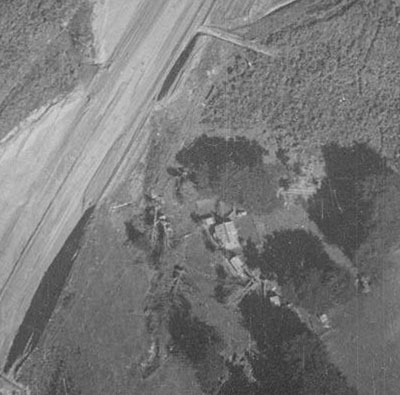
15 August 1949. Aviation photograph sourced from Retrolens online. Ref SN298. Image shows the storm damage of 1947 with fallen trees around the Perry house. The earthworks is the construction of the motorway.
Barney Perry
"There was a terrible storm after the War, in 1947. I remember looking out the window and screaming with fear watching the trees falling over. They smashed up all the cow bails, pens and stables. Three or four of those trees dropped on the driveway."
"Dad and a mate got out the cross cut saw and went to cut one up. It would have been two metres in diameter. When they cut through, we found an old stone beer bottle in the middle of the trunk, so you can imagine how long it had been sitting in that tree! That driveway was hard on Dad. There were always slips."
Mike's adventures on the steep driveway
Play buddies
"In addition to my family, my play buddies were the Cameron's and Neville Trendle, Brian Savage and the Molloy’s and Peter Richardson. We knew the Dorset’s as they went to school with us."
"We spent a lot of time playing in the creek behind the house and in the creeks at the bottom of the driveway. We went eeling under the bridge at the bottom of the drive. We didn’t eat the eels. The bridge wasn’t concrete, I seem to remember them as wooden bridges."
Post Office
"There was no old red Post Box at the bottom of the drive in my time, however there was a Post Office at the bottom of the hill and Mrs Ross ran the post. We had a mailbox at the bottom of the drive, it was on the inside, against the bank." [Ed. The Post Office is now a private home at 281 Middleton Road].
Carting down the driveway
"That driveway was a frightening thing. We had a box cart on pram wheels and used to cart down the track on it, then we would push it back up again."
Nearly struck by lightning
"One day I was on the driveway walking to the bottom of the hill on my way to school, when there was a terrible storm and some fork lightning struck the tree right in front of me. It would have been only three feet away. The tree split right in front of me and it was terrifying and I went straight back home."
1928 Essex Super Six over the bank
"The Molloy’s had a 1928 Essex Super Six. One day Pat Molloy insisted on driving up the hill after Church to drop us off. We kept saying “No, we’ll walk” but he wouldn’t hear of it, and attempted to drive up. The car went over the bank, just balancing there with the front over the bank. He had to leave it there overnight until a group of men could come with rope and help haul it back onto the drive."
"Graham had come home from Navy for a visit and was incredulous, bursting into the house saying “What’s that car doing hanging off the driveway!”.
The deep gully
"Behind the house was a deep gully with a nice creek in it. It was a good creek with a good flow. We used to play down there a lot. We used the bank as a backstop for shooting."
"Graham was a great shooter. He would come home from the Navy and go straight out on the farm for a shoot. He would hunt on the hills behind the house for pigs, deer or rabbits. He kept his guns just inside the corner of the kitchen, by the passage here."
Farm dog
"We had a dog. We found it on the main road. It must have fallen off a truck or been struck by a vehicle as it had a dislocated shoulder. We took her home and Dad fixed the shoulder and this Collie heading dog became our pet. It was her job to bring the two cows in for milking. At three Dad would send her away to do it and by five the cows would be at the sheds ready for milking!"
When the prize cow went missing
"One other story I remember was that the Taylor’s farm at Taylor’s corner and they ran a local pound for stray animals. Mr Taylor held them until Council came and dealt with it."
"One day our good milking cow went missing and Dad was sure it had ended up at Taylors. He refused to go and get it and pay the exorbitant amount, but we needed our milk."
"Well, Graham came home from the Navy and heard about what happened with the cow. He went down with Dad in the middle of the night. They stretched the wire on the fence, and ushered her through, then they drove her back up the hill."
"In the morning Mr Taylor came up asking where our cow was and Dad was all innocence saying she was in the paddock where she usually is. Taylor couldn’t do anything about it as he had no proof. When he said she had been down in his pound, Dad said she must have ‘wandered back’."
The grave
"I knew about the old grave down Stebbing’s road however I couldn’t tell you about it. There was another grave, there were two. The other one was up past Molloy’s. It had broken concrete on the surface and a wrought iron fence around it. I don’t know the story behind it."
[Ed. note. Mike, Sue and I went for a drive, and Mike pointed out Edward Wilson’s former driveway, now Edward Wilson Reserve and said that the grave-site was up the driveway.]
Barney's adventures
The big gully
"I once buried some treasures in the gully behind the house in a metal box. There had been a Tiger Moth crash across the way and I had a piece of ply from it. I buried that along with a Maltese cross."
"I am amazed about the gully being filled in. It used to be so pretty down there with the pussy willow. We used to play in the water, and after a rain, there was a lot of water. Our neighbours were the Curruthers, and my friend and I used to go floating about in half a 44 gallon drum in that gully."

The railway viaduct in Glenside, photographed by an Evening Post newspaper photographer in 1951. Source: Alexander Turnbull Library reference 114/409/08-G.
'At the top of the gully, south of the house, there was a wooden access bridge which went over the railway. It was a wooden one, you could drive across it. We used to walk over it and then go along the great railway viaduct. That was a scary walk, with the wooden boards rotting and the wind whistling around your ears."
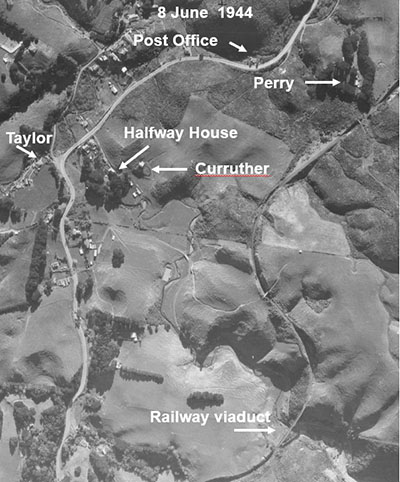
1944. Aviation photograph sourced from Retrolens online. Ref. SN298
"I used to go on long walks and explore around the area as I got older. The corner of the main road where the cutting is was known as "Piebald Corner" and if you went north of it and walked 50 yards down the bank to the water, you would find wild strawberries growing."
"We used to roam up Stebbings Road and swim in Moxies Pond (a Stebbings creek swimming hole). There were old gold shafts to be discovered from old mines and the remains of the settler’s homes could be seen with their brick chimneys. Florio Zande ran the 'Bucket Tree' and we would go down there. Another place of interest was the Downers Community Hall, which was really their mess room. Mum and Dad's farewell was held there."
Railway tragedy
"In those days we kids called Rowells Road, the Silver Road, because of the silver shingle laid on it. I once saw a terrible tragedy on the new railway. At the time I was doing my paper run and I was delivering the paper for Bob Blackbee, who lived opposite Dorset's place. Two girls had been blackberry picking and when they went to cross the line, they were killed by a train. One was a Whitcombe aged 13. I didn't see them killed, but I saw the trains stopped and wondered why and went over to have a look. I didn't go close but saw the girls laid out beside the line."
Mike Perry remembers Guy Fawkes night and the Dorset family
"We used to have our fireworks and bonfire night down at Dorset’s. That was great fun. Mr Dorset had a motorbike and we would hear him singing as he rode it. We called the road they lived on “Silver Road” due to the colour of the shingle on it. When he shot the guy, we all heard about it the next day at school but we never saw the Dorset children again. They just disappeared." [Ed. note. Dorset shot his wife's lover and was convicted of manslaughter in 1956. He was sentenced to one year of imprisonment].
"The other scandal was a German from the Prisoner of War camp marrying a local girl. The community was so judgemental that they would not sit in the same pew with them in Church."
"There was an artist that used to come here and paint local scenes."
Leaving Glenside
Barney Perry
"I went off into the Navy in 1951 and Mum and Dad moved in 1958. They swapped their house with Archer & Lupp, the Jaguar car people from Christchurch. They had been living at 14 Sylvia Street in Brighton. He was Len Archer and she was Sybil. She used to race cars and wrote a column in the newspaper "Sold on Sybil" about the cars. [Ed note. Barney didn't think any money exchanged hands however research revealed that payments were made].
Barney's final comment
"It was a great place to live as a boy growing up. We had the solitude but were always handy to a bus into town. I loved it there."